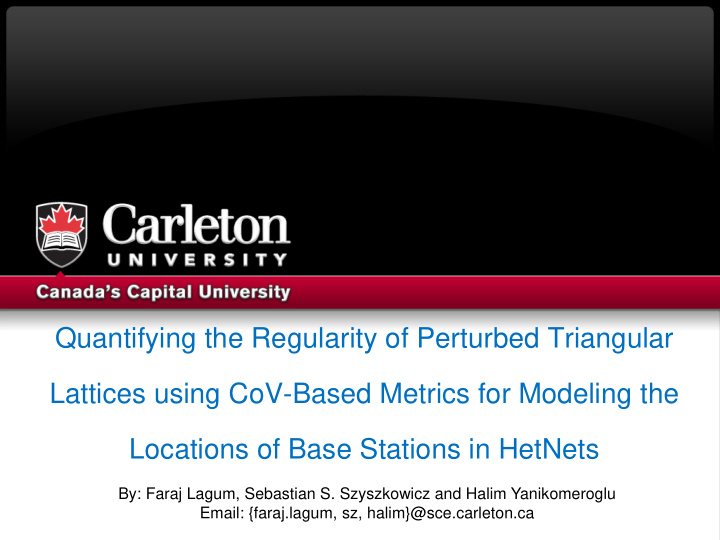



Quantifying the Regularity of Perturbed Triangular Lattices using CoV-Based Metrics for Modeling the Locations of Base Stations in HetNets By: Faraj Lagum, Sebastian S. Szyszkowicz and Halim Yanikomeroglu Email: {faraj.lagum, sz, halim}@sce.carleton.ca
Motivation Q: Are these two Base station (BS) locations similar in terms of regularity and network performance?
Motivation Q: Are these two Base station (BS) locations similar in terms of regularity and network performance? A: Yes, they are alike in terms of regularity and signal-to- interference ratio (SIR)!
Motivation Q: Are these two Base station (BS) locations similar in terms of regularity and network performance? A: Yes, they are alike in terms of regularity and signal-to- interference ratio (SIR)!
Motivation
Regularity CoV-Based Metrics The coefficient of variation (CoVs) of three geometric properties of point processes: - CoV of the Lengths of Delaunay Triangulation Edges - CoV of the Areas of Voronoi Tessellation Cells - CoV of the Distances to the Nearest Neighbour
BS locations with different amount of regularity
Effect of regularity on SIR
Perturbed Triangular Lattices (PTLs) Why do use the PTL models for BS deployment? - Simple implementation, used in industry - Span the whole range of regularity - Tractable (Banani, Adve, and Eckford, 2015)
Perturbed Triangular Lattices (PTLs) How to generate the PTL? - Start with triangular lattice (in blue) - Independent perturbation (e.g, uniform on disc , or Gaussian) - Tunable amount of regularity
Regularity of PTLs
Matching Gaussian and Uniform PTL
Matching Gaussian and Uniform PTL
Matching Gaussian and Uniform PTL Matching and interchanging the two PTL models, within about 0.1 dB error in SIR.
Hard-core Models F. Lagum, S. Szyszkowicz, and H. Yanikomeroglu, “CoV-Based Metrics for Quantifying the Regularity of Hard-Core Point Processes for Modeling Base Station Locations,” IEEE Wireless Commun. Lett., vol. 5, no. 3, pp. 276–279, June 2016.
Conclusion - We proposed a novel approach for mapping between two spatial models; Specifically, uniform PTL and Gaussian PTL using CoV-based metrics as an intermediate step. - We found a simple relation to match internal parameters two PTL. - We advocates modeling the placement of different types of BSs in HetNets using one of the PTL models, because of their simple and efficient implementation, their full regularity range (from the TL to the PPP).
Extensions to this work - Fitting real BS location data to RPP models using CoV- based metrics. - Fitting different types of RPP models to each other. - Ultimately, we would like to describe the spatial structure of any wireless network using only two scalars: the density of the BSs and a regularity metric value.
Recommend
More recommend